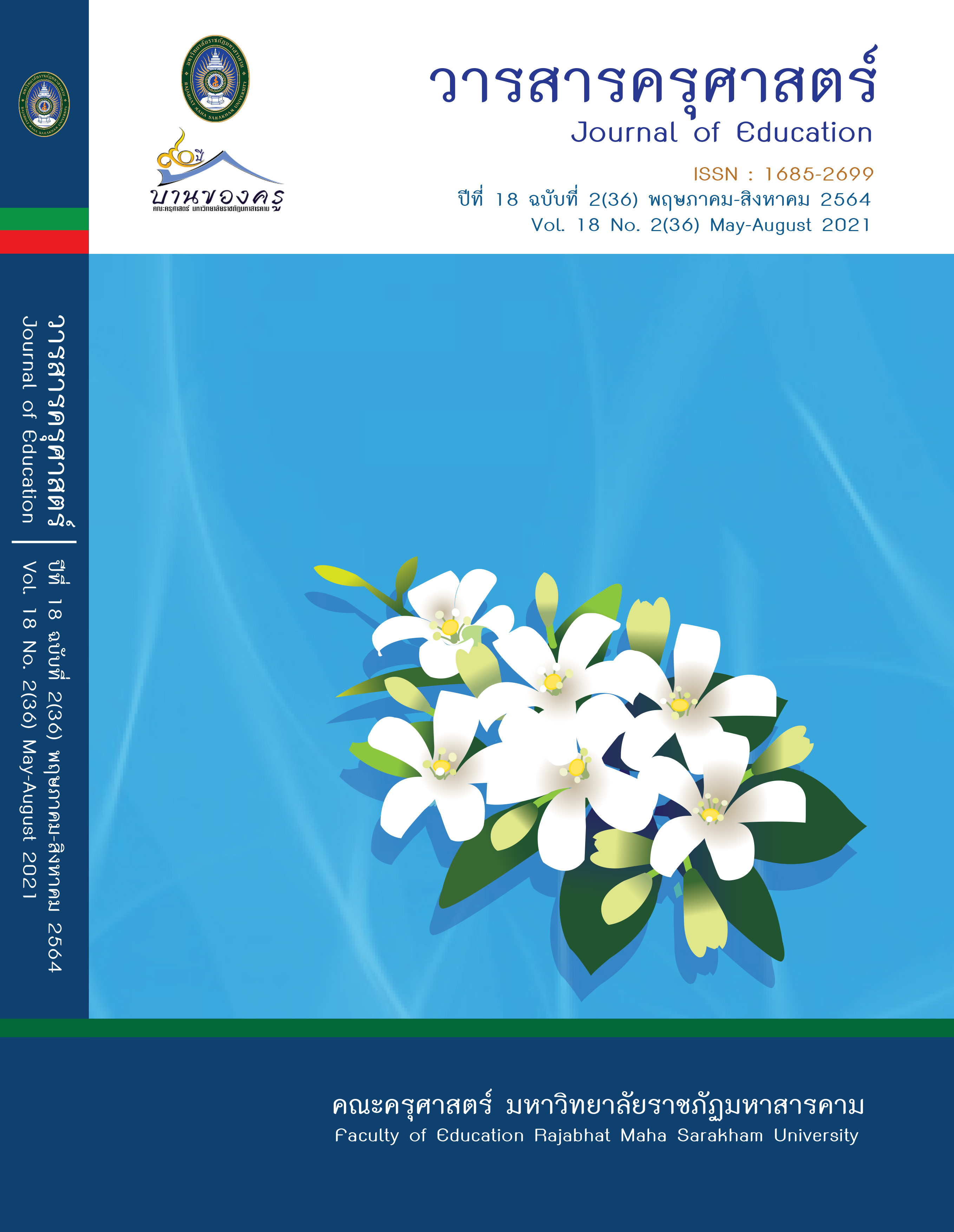The Learning Model of Integrated Agricultural Development with Community Participation for Students in HorwangPathumthani School
Main Article Content
Abstract
The purposes of this research were 1) To study the context and the environment before learning management in suitable agriculture for students; 2) To develop the learning model and integrated agricultural life skills; 3) To study the effects of using the learning model for developing integrated agricultural life skills. The target group was 357 high-school students in grade 12 by the purposive sampling technique. Research instruments were the activities observation assessment and questionnaire. The statistical data analysis was mean and percentage. The research revealed that 1) The context and condition were suitable for the overall learning management at a high level; 2) The learning model of integrated agricultural development was a total 4 suitable activities such as 1) economic animal husbandry, 2) hydroponic vegetable cultivation, 3) mushroom cultivation and 4) processing of rice berry products and showed that students had higher academic achievement before studying, a high level of occupational skills, and the trend of the skill development has continued to improve; 3) Effects of the integrated agricultural learning management with community participation usage were found that the students’ basically career skill was at a high level, as well as the students’ satisfaction of using the learning model of integrated agricultural development, was also high.
Article Details
ข้อกำหนดเบื้องต้นที่ผู้นิพนธ์(ผู้ส่งบทความ) ควรทราบ
1. ผู้นิพนธ์ที่ประสงค์จะลงตีพิมพ์บทความกับวารสาร ตั้งแต่เดือนมกราคม 2563 เป็นต้นไป ให้ใช้รูปแบบใหม่ (Template 2563) โดยสามารถดูตัวอย่างได้ที่เมนู GUIDELINES
2. จะตีพิมพ์และเผยแพร่ได้ ต้องผ่านการประเมินจากผู้ทรงคุณวุฒิ (Peer Review)
3. การประเมินบทความโดยผู้ทรงคุณวุฒิ (Peer Review) เป็นแบบ Double Blind
4. การอ้างอิงบทความใช้หลักเกณฑ์ APA (American Psychological Association) คลิก
5. บทความถูกปฏิเสธการตีพิมพ์ ไม่ผ่านการประเมิน ผู้นิพนธ์ขอยกเลิกเองหรือชำระเงินก่อนได้รับการอนุมัติ ทางวารสารไม่มีนโยบายการคืนเงิน
References
นันทวุฒิ มูลแสง. (2558). การพัฒนาทักษะการทำงานเป็นทีมด้วยบทเรียนบนเว็บที่ใช้วัฏจักรการสืบเสาะหาความรู้วิชาการเขียนโปรแกรมภาษาซี สำหรับนักเรียนชั้นมัธยมศึกษาปีที่ 4. [วิทยานิพนธ์ปริญญามหาบัณฑิต]. มหาวิทยาลัยราชภัฏมหาสารคาม,https://file/d/1gxt7CrQBRkxkh-CIraUvIyJPTs5KIkwK
นารีรัตน์ อินทรวิสัยและมณฑา จำปาเหลือง. (2558). การมีส่วนร่วมของผู้ที่มีส่วนได้ส่วนเสียในการพัฒนาคุณลักษณะอันพึงประสงค์ของนักเรียนโรงเรียนชุมชนประชานิคม สังกัดสำนักงานเขตพื้นที่การศึกษาประถมศึกษาชุมพร เขต 1. วารสารสาขามนุษยศาสตร์สังคมศาสตร์และศิลปะ.8(1), 856-867.
ประสงค์ ตันพิชัย. (2559). รายงานการวิจัยเรื่องการเชื่อมโยงเครือข่ายและการพัฒนาการเรียนรู้เพื่อการผลิตเห็ด.KasetsartJournnal of Social Sciences.37(2016), 255-266.
ปริญญา อันภักดี.(2558). การพัฒนาทักษะการทำงานเป็นทีมโดยจัดการเรียนรู้แบบโครงงานเป็นฐานผ่านสื่อสังคมออนไลน์วิชา IPST-MicroBOXของนักเรียนชั้นมัธยมศึกษาปีที่ 2 โรงเรียนชุมแพศึกษา. [วิทยานิพนธ์ปริญญามหาบัณฑิต ไม่ได้ตีพิมพ์]. มหาวิทยาลัยราชภัฏมหาสารคาม.
ปรีชา เนาว์เย็นผล. (2558). รายงานการฝึกอบรมหลักสูตรการเขียนและวิเคราะห์ข้อสอบวัดผลสัมฤทธิ์มหาวิทยาลัยสุโขทัยธรรมาธิราช.คณะศึกษาศาสตร์. มหาวิทยาลัยสุโขทัยธรรมาธิราช.
ปิยะพงษ์ ทรงประวัติ และอุบลวรรณ ส่งเสริม. (2558). การพัฒนากิจกรรมการเรียนรู้ทัศนศิลป์ด้วยวิธีซินเนคติกส์เพื่อส่งเสริมความสามารถในการสร้างสรรค์ภาพวาดสำหรับนักเรียนระดับชั้นประถมศึกษาปีที่ 4.วารสารสาขามนุษยศาสตร์สังคมศาสตร์และศิลปะ.8(1), 852-863.
พระราชบัญญัติแผนพัฒนาเศรษฐกิจและสังคมแห่งชาติ ฉบับที่ 12 ปีพุทธศักราช 2560 –2564. (2559, 30 ธันวาคม).ราชกิจจานุเบกษา. เล่ม 133 ตอนที่ 115. หน้าที่ 1-18.
วิชัย วงษ์ใหญ่. (2560). นวัตกรรมหลักสูตรและการเรียนรู้สู่ความเป็นพลเมือง.อาร์ แอนด์ ปริ้น.สำนักงานเลขาธิการสภาการศึกษาและกระทรวงศึกษาธิการ. (2560, 12 ตุลาคม).กรอบทิศทางแผนการศึกษาชาติปีพุทธศักราช 2560 – 2564.http://backoffice.onec.go.th/uploaded/Outstand/2016-EdPlan60-74.pdf.
อนันต์ ระงับทุกข์. (2562, 23 ตุลาคม). ศธ.ยอมรับเด็กไทยทักษะคิดวิเคราะห์. เดลินิวส์, 8-9.
อภิชาติ ใจอารีย์. (2559). กระบวนการมีส่วนร่วมแบบพหุภาคีเพื่อการจัดการสิ่งแวดล้อมอย่างยั่งยืน: กรณีศึกษาชุมชนบ้านพุเตย จังหวัดกาญจนบุรี.วารสารมหาวิทยาลัยศิลปากร.36(1) 111-136.
อมาวสี อัมพันศิริรัตน์ และพิมพิมล วงศ์ไชยา. (2560). การวิจัยเชิงปฏิบัติการแบบมีส่วนร่วม : ลักษณะสำคัญและการประยุกต์ใช้ในชุมชน. วารสารมนุษยศาสตร์และสังคมศาสตร์.36(6), 192-202.
อัมพล สุขศร. (2560). ปัญหาบางประการที่มีผลต่อการสอนภาคปฏิบัติวิชาเกษตรในโรงเรียนมัธยมศึกษาเขตการศึกษา 12 [วิทยานิพนธ์ปริญญามหาบัณฑิต ไม่ได้ตีพิมพ์]. สถาบันเทคโนโลยีพระจอมเกล้าเจ้าคุณทหารลาดกระบัง.
เอมอร อังสุรัตน์. (2559). การวิจัยเชิงบูรณาการในงานส่งเสริมการเกษตร. วารสารมหาวิทยาลัยเกษตรศาสตร์.36(1) 111-136.
Anne T.H, L.M. Karen, et al. (2002). A new wave of Evidence the Impact of School, Family and Community Connections on Student Achievement. Texas: National Center for Family and Community Connections with Schools
Blishen, E.(2013). Affective Characteristics and Teaching Skills of English Language Teachers: Comparing Perceptions of Elementary, Secondary and High School Students. Creative Education, 4(2), 7.
Bruner, J. (1976). The Process of Education: Revised Edition.Harvard University Press
Davies, I. K. (1971). Competency based learning: Technology, management,and design.. McGraw-Hill.
McNiff J. and Whitehead J. (2002). Action Research: Principle and Practice [2nd ed.].RoutledgeFalmer.


